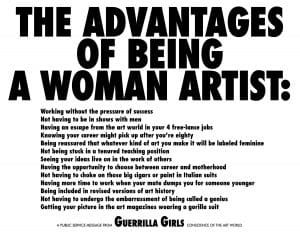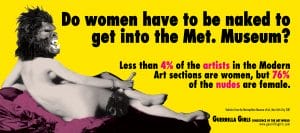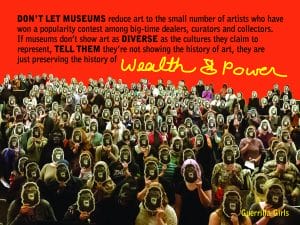
The Advantages of Being a Woman Artist, 1988, Guerrilla Girls
Feminism—a term that holds so much weight, especially in recent times, when the #MeToo and #TimesUp movements are giving tormented women courage and support to finally speak up about personal encounters of sexual harassment, while shining the spotlight on social inequality. Within this discourse of male versus female, black versus white, Guerrilla Girls, an anonymous feminist art collective made up of activists that go by pseudonyms, has devoted to challenging the status quo through statement posters. Using names such as “Frida Kahlo” and “Zubeida Agha” to identify themselves, the group has been fighting against discrimination of female artists and artists of colour since 1985.
But is anyone listening, or better yet, acting on righting the wrongs of gender imbalance? Taking it beyond art, the facts and statistics of female representation also make up the driving force of this collective. The Guerrilla Girls are no strangers to controversy, and the choice to remain anonymous, by wearing a gorilla mask and using pseudonyms of iconic artists, keeps the attention on their long pursuit of universal acceptance and female rights.

Do women have to be naked to get into the Met. Museum?, 1989, Guerrilla Girls
What does “diversity” mean to Guerrilla Girls? Is it just about increasing the number of female representation in art museums and archives?
No, it’s definitely much more than that. It’s about making sure our cultural institutions reflect the community. Gender, race, sexual orientation, socio-economic status, differing abilities—all these factors affect diversity. We are fighting for everyone to be represented. The history of cultural institutions will be incomplete otherwise.
Is public inclusivity a big part of the work of Guerrilla Girls?
Always. Our work began on the street, and driving change involves everybody, regardless of the community. We want to talk to the public, and not just the rarified art world. The social norms won’t change unless the people demand it.
What sort of change does Guerrilla Girls hope to see in the arts industry, in the near future? What changes has the group contributed to in the past 10 to 20 years?
We will be bold and claim some credit for challenging the notion that the art world is a meritocracy. Everyone now understands that there are systematic obstacles for everyone and that white men are privileged in the system.The conversation about diversity in the art world has changed, but sadly, the numbers haven’t caught up. While men still get more professional opportunities, and the growing influence of big money exacerbates this, we’d like to see real diversity in our cultural institutions, and for art to cease being the plaything and investment tool of the super-wealthy.
Guerrilla Girls has protested at contemporary art fairs such as Art Basel Hong Kong and criticised renowned institutions. Has the group always been so vocal from the start? How do you choose your audience?
We have always been direct and in-your-face. Our first few posters that appeared on the streets of NYC overnight, named names, pointed fingers, and made lots of people in the art world uncomfortable. It’s not our style to be discreet and polite. We choose our targets, and we find a way to make ourselves heard. We are not afraid to make critical statements that are unforgettable to whoever is listening.

History of Wealth and Power, 2016, Guerrilla Girls
What is a defining moment for Guerrilla Girls in the past 33 years?
There have been so many moments, it would be hard to pick one, and I’m sure each member would pick a different moment. But we would all agree that humour has been the key to our success. You can’t just point at something and say, “this is bad”. You have to do more; you have to take the message and twist it so it becomes memorable. If you can make someone who disagrees with you laugh, you have a hook in their brain and a better chance of convincing them.
As contemporary artists, how do you all relate to women painters from past centuries? Does art history inform the work of Guerrilla Girls?
We are committed to demanding that art history be as diverse as the culture whose story it claims to write. Otherwise, it’s not a rich, complete history. There have always been women artists—just because the academics and royal courts didn’t champion them doesn’t mean women weren’t making art. Art historians need to work harder. We need to cement a place for women in art history.
What is one message that the world should hear from Guerrilla Girls?
Don’t let museums reduce art to the small number of artists who have won a popularity contest among big time dealers, curators, and collectors. If museums don’t show art as diverse as the cultures they claim to represent, tell them they are not showing the history of art, they are just preserving the history of wealth and power.
Guerrilla Girls is showing in ‘Andy Warhol and The Guerrilla Girls’ until December 17 at Tate Modern, London. www.guerrillagirls.com



